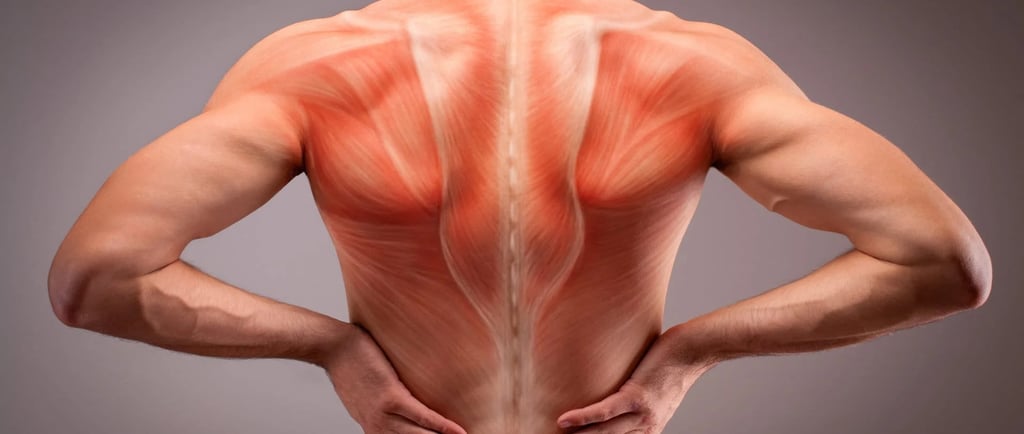Back
Extrinsic (Superficial): The Trapezius elevates, retracts, and depresses the shoulder blade. The Latissimus Dorsi extends, adducts, and internally rotates the arm (like in pull-ups).
MUSCLE GROUP
9/28/20253 min read


Back and Workout Variations with Warnings
The back is one of the largest and most powerful areas of the human body. A well-developed back not only creates an impressive V-taper physique but also supports posture, spinal health, and nearly all functional movements. From carrying groceries to performing athletic lifts, the back is constantly at work. Training it properly is essential for strength, balance, and injury prevention.
Anatomy of the Back
The back consists of several major muscle groups working together:
Latissimus dorsi (lats) – the broad muscles on the sides of the back, responsible for pulling and giving the torso width.
Trapezius (traps) – extends from the neck to mid-back, involved in shrugging, pulling, and posture support.
Rhomboids – located between the shoulder blades, helping retract the scapula.
Erector spinae – runs along the spine, responsible for extension and maintaining upright posture.
Teres major/minor & infraspinatus – small muscles supporting rotation and pulling movements.
Rear deltoids (part of shoulder) – also assist in back movements like rows and pulls.
Together, these muscles stabilize the spine, support the arms and shoulders, and power pulling movements.
Importance of Back Training
Building a strong back offers multiple benefits:
Improved posture – prevents slouching and keeps shoulders aligned.
Balanced physique – complements chest and shoulder training for symmetry.
Functional strength – essential for lifting, pulling, and carrying heavy loads.
Athletic performance – enhances power in sports like swimming, rowing, climbing, and wrestling.
Injury prevention – strengthens spinal support, reducing risk of lower back pain.
A weak back can lead to poor posture, shoulder injuries, and imbalances that affect overall performance.
Back Workout Variations
Here are some of the best exercises to target all areas of the back:
1. Pull-Ups / Chin-Ups
Grip bar with palms forward (pull-up) or facing you (chin-up).
Pull body upward until chin clears bar.
👉 Builds lats, traps, and biceps.
2. Lat Pulldowns (machine)
Sit at machine, grip bar wider than shoulders.
Pull bar down to chest, keeping torso upright.
👉 Great alternative to pull-ups for beginners.
3. Barbell Rows
Hold barbell with overhand grip.
Bend forward at hips, back straight.
Pull bar toward lower chest, then lower slowly.
👉 Builds thickness in middle back and traps.
4. Dumbbell Rows
Place one knee and hand on a bench.
Row dumbbell toward waist with opposite hand.
👉 Isolates lats and improves unilateral strength.
5. T-Bar Rows
Stand over T-bar, grab handles.
Row toward chest while keeping back flat.
👉 Adds density to middle back.
6. Deadlifts
Stand with barbell on floor.
Hinge at hips, grip bar, and lift by driving hips forward.
👉 Builds erector spinae, traps, glutes, and overall strength.
7. Face Pulls
Attach rope to cable machine at face height.
Pull rope toward forehead, elbows high.
👉 Strengthens rear delts and upper back.
8. Seated Cable Rows
Sit at machine, grip handle.
Pull toward waist, squeezing shoulder blades.
👉 Works middle back and rhomboids.
9. Shrugs
Hold dumbbells or barbell at sides.
Shrug shoulders upward, hold, then lower.
👉 Targets trapezius muscles.
10. Hyperextensions (Back Extensions)
Lie on hyperextension bench, hips on pad.
Lower torso down, then raise back up.
👉 Strengthens erector spinae and lower back.
Warnings and Safety Tips
The back is powerful but also vulnerable, especially the spine. Improper training can lead to strains, disc injuries, or chronic pain. Keep these warnings in mind:
1. Warm Up Properly
Always warm up with light cardio and dynamic stretches before heavy back exercises like deadlifts or rows.
2. Maintain Neutral Spine
Never round your back in deadlifts, rows, or squats. Keep the spine neutral to protect against herniated discs.
3. Control the Weight
Avoid jerking or yanking weights, especially in pull-downs or rows. Controlled movement ensures muscle activation and reduces injury risk.
4. Don’t Neglect Lower Back
Focusing only on lats and traps can leave the lower back weak. Include hyperextensions or deadlifts for balanced development.
5. Grip Variation Matters
Overusing one grip type can stress joints. Rotate between overhand, underhand, and neutral grips.
6. Avoid Excessive Heavy Shrugs or Upright Rows
Using very heavy weights with poor form can compress shoulder joints and strain traps.
7. Balance Push and Pull
Pair back exercises with chest and shoulder training to avoid rounded posture.
8. Progress Slowly
Deadlifts and rows are powerful but taxing. Increase weights gradually to protect joints and tendons.
9. Use Supportive Gear Wisely
Lifting belts and straps can help with very heavy lifts but should not replace proper form.
10. Listen to Your Body
Sharp pain in lower back or shoulders is a warning sign. Stop immediately and reassess form or reduce weight.
Final Thoughts
The back is a cornerstone of strength and posture. From the broad lats that create a V-shape to the stabilizing erector spinae along the spine, every muscle in the back plays a critical role in movement and performance. With exercises like pull-ups, rows, deadlifts, and face pulls, you can build a strong, balanced back that enhances both aesthetics and functionality.
However, safety must always come first. The spine and shoulders are vulnerable to poor technique, so controlled movement, proper form, and gradual progression are essential. By training all areas of the back — upper, middle, and lower — while respecting recovery, you’ll create a resilient, powerful, and well-developed back that supports both fitness goals and daily life.
